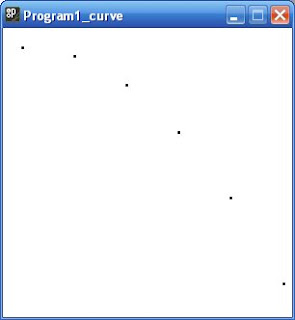However, I haven't been idle, and have given much thought to the project.
So now I have the first part of my Chunk (50) written, and here it is :
CHUNK 50
TITLE Generating a simple curve
In the previious section you was able to see how a graph of distance against time could be represented with a curve.
Also, you saw that for a given constant speed (i.e. zero acceleration), a straight line is drawn, because
In other words the slope of the line determines the speed.
In many cases speed is not constant and so a curve will be drawn instead. This can be interpreted as a line with a varying slope.
But how do we draw lines with varying slope in the Processing Environment ?
First, we need a function to describe the shape of the curve. One frequently used case, is when a ball or other object is dropped from a height. We can describe the speed of the object in terms of the amount of time elapsed from dropping the object approximately as follows :
Where 's' is the number of seconds since dropping the object and '9.81' is the constant acceleration due to the gravitational pull of the earth. This is a form of constant aceeleration in one dimension.
Lets develop a program to draw this graph
First, we need an anvironment to draw in :
size(300,300);
background(255);
int margin = height / 15;
strokeWeight(3);
smooth();
Now define the x an y values for plotting the points
float x = 0;
float y = 0;
We need a constant to represent the acceleration due to gravity
float g = 9.81;
This constant we will use to increment the x (time) value.
float timeInc = 1;
We need to scale the x-points according to the size of the window. This constant calculates the maximum valkue of x that we can expect during the execution of the program.
float xMax = width/sqrt(width / g);
Now we are ready to run the program. A 'whjile' loop is used to calculate values for y, as long as the current value will fit into the window.
while(y
Work out where the x point is in terms of time:
float xPoint = xMax * x;
Tell us what is going on (for information only)
System.out.println("x=" + x + ", y=" + y + ", xPoint=" + xPoint);
Draw the point on the graph
point(xPoint+margin, y+margin);
Increment time by our required factor. Calculate the next value of y , and starty again
x += timeInc;
y = g * x*x;
}
Put together, this program looks like this :
// Set the environment
size(300,300);
background(255);
int margin = height / 15;
strokeWeight(3);
smooth();
// Set constants
float x = 0;
float y = 0;
float g = 9.81;
float timeInc = 1;
float xMax = width/sqrt(width / g);
// Run the loop
while(y
float xPoint = xMax * x;
System.out.println("x=" + x + ", y=" + y + ", xPoint=" + xPoint);
point(xPoint+margin, y+margin);
x += timeInc;
y = g * x*x;
}
Using the code above, I obtained the following output:
You can see that five points were plotted representing the time values of 0 -4 seconds after release of the object, in one second increments.
You should be able to easily change this program to show the curve as below :
Hint : look at the value of timeInc


